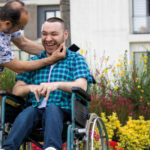
By Gary Fitzgerald, chief executive of Action on Elder Abuse
The recent revision of the Care Act statutory guidance provided a significant opportunity to improve practice in adult safeguarding.
This is because the Department of Health drafted the Care Act in such a way that its legislative content in relation to adult safeguarding was minimal. It only defined the infrastructure for adult safeguarding that must exist in local areas – safeguarding adult boards, the duty to make safeguarding enquiries in certain circumstances and provisions for sharing information and carrying out safeguarding adult reviews in serious cases.
It was left to the statutory guidance to set out how this should be applied in practice and define the philosophy and expectations of adult safeguarding in England. The first version of the guidance, published in 2014, was inadequate in this respect. But despite various changes to the chapter on adult safeguarding in the revised version, published this month, what’s been produced is disappointing.
We need much clearer guidance if we want safeguarding intervention to be consistent, supportive and effective.
Three obvious areas of concern are:
When does an individual qualify for an adult safeguarding investigation?
Guidance is supposed to elaborate and expand on legislation but the latest version simply paraphrases the Care Act. It states that safeguarding duties apply to an adult who:
has needs for care and support whether or not the local authority is meeting any of those needs;
- is experiencing or at risk of abuse or neglect;
- as a result of those care and support needs is unable to protect themselves from either the risk of or the experience of abuse or neglect.
Under section 42 of the act, this triggers the local authority’s duty to make safeguarding enquiries to decide what must be done to protect the adult. But across England there are variations in how this is being interpreted, depending on who receives the concern, how narrowly the legislation is being interpreted, and the impact of timescales and work pressures. But neither the original nor the revised guidance has provided advice on how to interpret this provision.
In some areas, abuse by a care worker might not result in an investigation if the abuser has been suspended, because the victim is no longer ‘experiencing or at risk of abuse’. This prevents any multi-disciplinary understanding of the causes or future consequences of what happened.
We need guidance on how to interpret this clause and what actions should be taken where victims are unable to protect themselves from abuse but have no care and support needs. For example, it is not certain that a victim of financial abuse, subject to ongoing undue influence, would receive support if their inability to protect themselves was not linked to ‘care and support needs’.
Self-neglect
The inclusion of ‘self-neglect’ in the original statutory guidance, as a type of abuse or neglect that may prompt an enquiry, came as a surprise, with many practitioners struggling to know the best way of managing and responding to such referrals.
The revised guidance includes further information on self-neglect but is not helpful. It tells us that self-neglect may not prompt a section 42 enquiry, and that this will depend ‘on the adult’s ability to protect themselves by controlling their own behaviour’. An adult deemed able to protect themselves would not qualify for a safeguarding enquiry. But given that self-neglect is a behavioural condition, it is difficult to understand, let alone apply, such guidance.
There are two broad categories of self-neglect to consider: firstly, situations where self neglect is a chosen lifestyle, and secondly, those situations in which self neglect is caused through external factors, such as a loss of income or the death of a relative.
If safeguarding is to address self-neglect then the guidance needs to help practitioners differentiate between these circumstances, identify trigger points for action, and elaborate on the right to choice, control and make unwise decisions versus the need to protect the individual and the wider community.
Domestic violence
The revised guidance highlights the new offence of coercive and controlling behaviour in intimate and familial relationships, which came into force at the end of last year. While this is welcome, the guidance provides no direction on how it should be interpreted or implemented.
We know that a significant percentage of elder abuse is covered by the cross-government definition of domestic violence but this does not always translate into safeguarding understanding or practice. The guidance needs to be far more comprehensive if we are to ensure that the law is appropriately applied.
‘Not enough’
If there had been a greater emphasis on adult safeguarding in the Care Act itself, then perhaps there would not be such a need for clear and explicit messages from the statutory guidance. But one thing is clear – it is not enough to simply reflect the wording of the legislation, without explanation or elaboration, or to simply draw attention to aspects of abuse. This is what the existing guidance does repeatedly on key issues and as it stands, the need for a third version is likely to become self-evident in due course.




 Bournemouth, Christchurch and Poole
Bournemouth, Christchurch and Poole  Hampshire County Council
Hampshire County Council  Oxfordshire County Council
Oxfordshire County Council  South Gloucestershire Council
South Gloucestershire Council  Wokingham Borough Council
Wokingham Borough Council  Providing a lifeline for social workers who want to get back into the sector
Providing a lifeline for social workers who want to get back into the sector  The highs and lows of a children’s services’ transformation journey
The highs and lows of a children’s services’ transformation journey  Embedding learning in social work teams through a multi-agency approach
Embedding learning in social work teams through a multi-agency approach  The family safeguarding approach: 5 years on
The family safeguarding approach: 5 years on  Harnessing social work values to shape your career pathway
Harnessing social work values to shape your career pathway  Workforce Insights – showcasing a selection of the sector’s top recruiters
Workforce Insights – showcasing a selection of the sector’s top recruiters  Join our team to help technology enabled care transform lives in Nottinghamshire
Join our team to help technology enabled care transform lives in Nottinghamshire 

 Facebook
Facebook X
X LinkedIn
LinkedIn Instagram
Instagram
Relatives at York Court care home in Battersea that closed Dec 2015 raised alerts that constituted safeguarding including grade 3 pressure ulcer – to date since Jan 2015 this has not been dealt with as a safeguarding in spite of the fact that home had a serious service level safeguarding going on at the time
and a safeguarding from was sent to the LA about the avoidable grade 3 pressure ulcer that evidently starts as a grade 1 and was ignored and got worse lack of equipment – poor care etc etc
Relatives excluded from the safeguardings they have raised no feed back no inclusion as witnesses – professional to professional process excluding all others
safeguarding policy ignored mca ignored care act ignored rights we and service users have but are prevented from exercising all responsible no one responsible the complicity is rife no enforcement of the MCA 2005 11 years on
When policies etc use the word should instead of must – the loop holes are set – who will enforce any policies or acts…
I couldn’t agree more.
If someone who has a learning disability is being exploited, but they have no care and support needs, how can it be that this doesn’t meet the threshold for enquiry…? I know that we can make non-statutory enquires (again not defined in guidance), but this just doesn’t seem right.
I think the threshold should be more like:
-has an impairment or illness (regardless of whether or not the local authority is meeting any related needs);
-is experiencing or at risk of abuse or neglect;
-as a result their impairment or illness, is unable to protect themselves from either the risk of or the experience of abuse or neglect.
Then non-stat enquires could be for carers or people who don’t necessarily have an impairment or illness, but are perceived as being vulnerable, ie. Someone with learning difficulties (not learning disability) who has care and support needs do to circumstantial factors (eg. Care leaver).